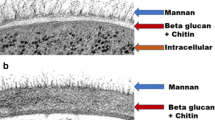Abstract
(1 → 3)-β-D-Glucans have received much attention with respect to their biological functions. A novel method to extract (1 → 3)-β-D-glucan from Saccharomyces cerevisiae cell wall is proposed in present work, which is based on the combination of induced autolysis and subsequent oxidation of the autolysed cell by sodium hypochlorite to remove undesirable substances. Influences of temperature, pH value and organic solvent on S. cerevisiae FL 1 autolysis were investigated. Results indicated that each factor had its significant effect on induced autolysis and the optimal conditions were 52 °C, pH 5.5 and 1.5% (v/v) ethyl acetate. The kinetic behaviour of the yeast autolytic process under the optimized conditions was further studied. After 36 h of autolysis, 42.0% (w/w) cellular substances were released while the cell wall nearly remained intact. Finally, an ideal glucan yield as high as 22.9% (w/w) was obtained when S. cerevisiae FL 1 was treated by the novel method.
Similar content being viewed by others
References
Adolfo, M.R. & Polo, M.C. 2000 Characterization of the nitrogen compound released during yeast autolysis in a model wine system. Journal of Agricultural and Food Chemistry 48, 1081–1085.
Dubois, M., Gilles, K.A., Hamilton, J.K., Rebers, P.A. & Smith, F. 1956 Colorimetric method for determination of sugars and related substances. Analytical Chemistry 28, 350–356.
Liang, J.S., David, M., Lauren, C., Gerard, P., Leslie, F. & Robert, A. 1998 Enhanced clearance of a multiple antibiotic resistant Staphylococcus aureus in rats treated with PGG-glucan is associated with increased leukocyte counts and increased neutrophil oxidative burst activity. International Journal of Immunopharmacology 20, 595–614.
Luyten, K., Albertyn, J., Skibbe, W.F., Prior, B.A., Ramos, J., Thevelein, J.M. & Hohmann, S. 1995 Fps1, a yeast member of the MIP family of channel proteins, is a facilitator for glycerol uptake and efflux and is inactive under osmotic stress. EMBO Journal 14, 1360–1371.
Martýnez-Rodrýguez, A.J., Polo, M.C. & Carrascosa, A.V. 2001 Structural and ultrastructural changes in yeast cells during autolysis in a model wine system and in sparkling wines. International Journal of Food Microbiology 71, 45–51.
Mathlouthi, M. & Koenig, J.L. 1986 Vibrational spectra of carbohydrates. Advances in Carbohydrate Chemistry and Biochemistry 44, 7–89.
Mueller, A., Raptis, J., Rice, P.J., Kalbfleisch, J.H., Stout, R.D., Ensley, H.E., Browder, W. & Williams, D.L. 2000 The influence of glucan polymer structure and solution conformation on binding to (1 ? 3)-beta-D-glucan receptors in a human monocyte-like cell line. Glycobiology 10, 339–346.
Ohno, N., Miura, T., Miura, N.N., Adachi, Y. & Yadomae, T. 2001 Structure and biological activities of hypochlorite oxidized zymosan. Carbohydrate Polymers 44, 339–349.
Patchen, M.L., Liang, J., Vaudrain, T., Martin, T., Melican, D., Zhong, S., Stewart, M. & Quesenberry P.J. 1998 Mobilization of peripheral blood progenitor cells by Betafectin® PGG-Glucan alone and in combination with granulocyte colony-stimulating factor. Stem Cells 16, 208–217.
Pueyo, E., Martinez-Rodriguez, A., Polo, M.C., Santa-Maria, G. & Bartolome, B. 2000 Release of lipids during yeast autolysis in a model wine system. Journal of Agricultural and Food Chemistry 48, 116–122.
Šandula, J., Kogan, G., Kacuráková, M. & Machova, E. 1999 Microbial (1 ? 3)-?-D-glucans, their preparation, physico-chemical characterization and immunomodulatory activity. Carbohydrate Polymers 38, 247–253.
Tsiapali, E., Whaley, S., Kalbfleisch, J., Ensley, H., Browder, I.W. & Williams, D.L. 2001 Glucans exhibit weak antioxidant activity, but stimulate macrophage free radical activity. Free Radicals in Biology and Medicine 30, 393–402.
Williams, D.L., Pretus, H.A., McNamee, R.B., Jones, E.L., Ensley, H.E. & Browder, I.W. 1992 Development of water-soluble, sulfated (1 ? 3)-?-D-glucan biological response modifier derived from Saccharomyces cerevisiae. Carbohydrate Research 235, 247–257.
Author information
Authors and Affiliations
Rights and permissions
About this article
Cite this article
Wang, Y., Yao, S. & Wu, T. Combination of induced autolysis and sodium hypochlorite oxidation for the production of Saccharomyces cerevisiae (1 → 3)-β-D-glucan. World Journal of Microbiology and Biotechnology 19, 947–952 (2003). https://doi.org/10.1023/B:WIBI.0000007328.21451.78
Issue Date:
DOI: https://doi.org/10.1023/B:WIBI.0000007328.21451.78




